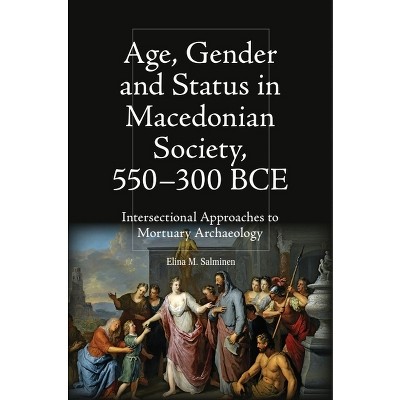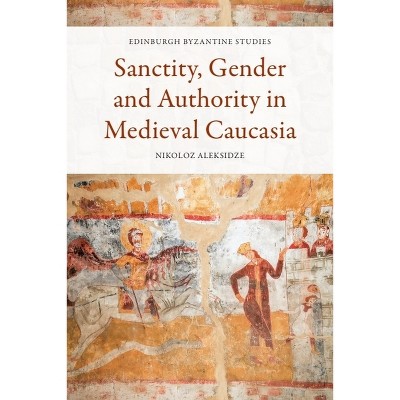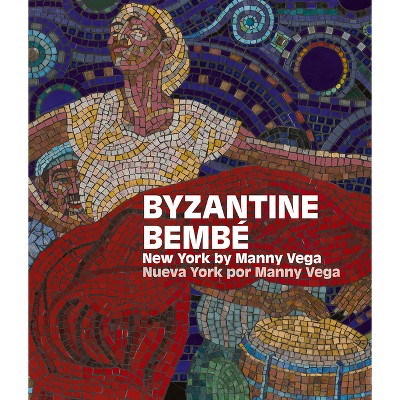$44.00 sale price when purchased online
$47.00 list price
Target Online store #3991
About this item
Highlights
- A fascinating history of marginalized identities in the medieval world While the term "intersectionality" was coined in 1989, the existence of marginalized identities extends back over millennia.
- About the Author: Roland Betancourt is professor of art history at the University of California, Irvine.
- 288 Pages
- Social Science, Gender Studies
Description
About the Book
"Intersectionality, a term coined in 1989, is rapidly increasing in importance within the academy, as well as in broader civic conversations. It describes the study of overlapping or intersecting social identities such as race, gender, ethnicity, nationality, and sexual orientation alongside related systems of oppression, domination, and discrimination. Together, these frameworks are used to understand how systematic injustice or social inequality occurs. In this book, Roland Betancourt examines the presence of marginalized identities and intersectionality in the medieval era. He reveals the fascinating, little-examined conversations in medieval thought and visual culture around matters of sexual and reproductive consent, bullying, non-monogamous marriages, homosocial and homoerotic relationships, trans and non-binary gender identifications, representations of disability, and the oppression of minorities. In contrast to contemporary expectations of the medieval world, this book looks at these problems from the Byzantine Empire and its neighbors in the eastern mediterranean through sources ranging from late antiquity and early Christianity up to the early modern period. In each of five chapters, Betancourt provides short, carefully scaled narratives used to illuminate nuanced and surprising takes on now-familiar subjects by medieval thinkers and artists. For example, Betancourt examines depictions of sexual consent in images of the Virgin; the origins of sexual shaming and bullying in the story of Empress Theodora; early beginnings of trans history as told in the lives of saints who lived portions of their lives within different genders; and the ways in which medieval authors understood and depicted disabilities. Deeply researched, this is a groundbreaking new look at medieval culture for a new generation of scholars"--Book Synopsis
A fascinating history of marginalized identities in the medieval world
While the term "intersectionality" was coined in 1989, the existence of marginalized identities extends back over millennia. Byzantine Intersectionality reveals the fascinating, little-examined conversations in medieval thought and visual culture around sexual and reproductive consent, bullying and slut-shaming, homosocial and homoerotic relationships, trans and nonbinary gender identities, and the depiction of racialized minorities. Roland Betancourt explores these issues in the context of the Byzantine Empire, using sources from late antiquity and early Christianity up to the early modern period. Highlighting nuanced and strikingly modern approaches by medieval writers, philosophers, theologians, and doctors, Betancourt offers a new history of gender, sexuality, and race. Betancourt weaves together art, literature, and an impressive array of texts to investigate depictions of sexual consent in images of the Virgin Mary, tactics of sexual shaming in the story of Empress Theodora, narratives of transgender monks, portrayals of same-gender desire in images of the Doubting Thomas, and stereotypes of gender and ethnicity in representations of the Ethiopian Eunuch. He also gathers evidence from medical manuals detailing everything from surgical practices for late terminations of pregnancy to save a mother's life to a host of procedures used to affirm a person's gender. Showing how understandings of gender, sexuality, and race have long been enmeshed, Byzantine Intersectionality offers a groundbreaking look at the culture of the medieval world.Review Quotes
"Byzantine Intersectionality is a compelling and timely intervention with methodological insights for the study of premodern history. Its significance lies in articulating not only the "why" but also advances on the "how" in terms of the unearthing of marginalized historical identities. . . . Betancourt [offers] a cogent demonstration that historical sources have more to tell us about the evolving landscape of consent, unequal access to reproductive healthcare, the politics of slut-shaming, transgender folk, same-gender desire, and how context affects the shifting intersections of ethnicity and gender."---Niamh Bhalla, Speculum
"Betancourt . . . [has produced] a methodologically complex and analytically nuanced study of Roman intersectional identities that adroitly draws on material culture, sacred art, and textual corpora that few scholars can navigate with such sophistication and dexterity. . . . Byzantine Intersectionality is a great service to scholars sympathetic to matters of social justice in relation to the excavation of the past, but who are unfamiliar with intersectional historiography. . . . Chapters Three and Five . . . are the most important contribution to the intersectional treatment of Roman transgender, nonbinary, and racialized identities so far penned by any scholar."---Luis Josué Salés, Journal of Early Christian Studies
"[A] provocative study of Byzantine sex and gender. . . . Byzantine Intersectionality is poised to make a difference. Wearing his ideology on his sleeve, Betancourt aims to compel Western medievalists to pay more attention to the East, while persuading conservative colleagues in his own field to broaden their views."---Barbara Newman, London Review of Books
"Winner of the Jerome E. Singerman Prize, Medieval Academy of America"
"[Byzantine Intersectionality] is an insightful and powerful new addition to not only Medieval Studies, but also History of Art, Critical Race Studies, Gender and Sexuality Studies and Queer Studies. . . . An exciting and radical new project with an ethical dimension and urgency, this text challenges the ways scholars have viewed Byzantine society and culture. . . . [This] innovative text provokes from the epigraph by Lewinsky to the final sentence with its ethical imperative for social and racial justice."---Meaghan Allen, LSE Review of Books
"[Byzantine Intersectionality] raises timely and pressing questions about gender, sexuality, marginalized groups, and diversity in the medieval Roman Empire. . . . This indispensable book makes clear that the study of Byzantine art is relevant and pressing today."---Armin Bergmeier, Art Bulletin
"[Byzantine Intersectionality] quotes Monica Lewinsky in its epigraph and brings an activist's zeal to its queer-theory close readings of texts and images from the Eastern Roman Empire between the fourth and fifteenth centuries. By scouring legal, medical, and religious sources, and reading misogynist invectives against the grain, Betancourt builds a fascinating picture of more fluid attitudes and practices around sexuality than have been suggested in the mainstream historical record. . . . The details Betancourt excavates can be as illuminating as they are juicy."---Lidija Haas, Harper's Magazine
"[The book's title] refers to the interaction between gender, sexuality and race, how the intersections between these three separate things were understood in Byzantine society and how these understandings endured or shifted across the period of the Empire's history from (roughly) the fourth century to the 15th. . . . The book is rooted in a huge number of meticulously studied late antique and medieval sources. Importantly, Betancourt allows them the freedom to speak for themselves."---Adele Curness, History Today
"A major accomplishment of [Byzantine Intersectionality] is its interdisciplinarity. As opposed to other scholars of the middle ages whose focus is narrowed to a specific discipline, Betancourt's text covers the large disciplinary gaps between literary studies, art history, and historical studies, to create a wide-ranging view of the period and allowing scholars to create thematic connections previously unknown across the disciplines. . . . Another important aspect of this text is the potential implications for the field moving forward. Betancourt's recalibration of the definitions of sexuality, gender, and race has opened countless doors for other medievalists to analyze literature, historical documents, and art for the sole purpose of expanding known histories of sex, gender, and race."---Morgan Connor, Pennsylvania Literary Review
"Every Byzantinist needs to read this book. . . . A highly stimulating and thought-provoking book. It is also a beautifully produced book."---Shaun Tougher, Medieval Encounters
"Finalist for the Award for Excellence in the Study of Religion, Historical Studies, American Academy of Religion"
"This book is for the outcast and for those who inhabit the margins of the past and present. . . . Byzantine Intersectionality provides art historians, archaeologists, and historians with a better theoretical basis for reconstructing the complex lived reality of queerness, sexual violence, consent, and racial profiling. The marginalized biblical figures and saints examined together serve as a new testament to how engrained systematic oppression functions in society."---Sarah E. Bond, Hyperallergic
About the Author
Roland Betancourt is professor of art history at the University of California, Irvine. He is the author of Performing the Gospels in Byzantium and Sight, Touch, and Imagination in Byzantium.Dimensions (Overall): 9.2 Inches (H) x 6.1 Inches (W) x 1.2 Inches (D)
Weight: 1.4 Pounds
Suggested Age: 22 Years and Up
Number of Pages: 288
Genre: Social Science
Sub-Genre: Gender Studies
Publisher: Princeton University Press
Format: Hardcover
Author: Roland Betancourt
Language: English
Street Date: October 6, 2020
TCIN: 83868147
UPC: 9780691179452
Item Number (DPCI): 247-28-1969
Origin: Made in the USA or Imported
If the item details above aren’t accurate or complete, we want to know about it.
Shipping details
Estimated ship dimensions: 1.2 inches length x 6.1 inches width x 9.2 inches height
Estimated ship weight: 1.4 pounds
We regret that this item cannot be shipped to PO Boxes.
This item cannot be shipped to the following locations: American Samoa (see also separate entry under AS), Guam (see also separate entry under GU), Northern Mariana Islands, Puerto Rico (see also separate entry under PR), United States Minor Outlying Islands, Virgin Islands, U.S., APO/FPO
Return details
This item can be returned to any Target store or Target.com.
This item must be returned within 90 days of the date it was purchased in store, shipped, delivered by a Shipt shopper, or made ready for pickup.
See the return policy for complete information.












